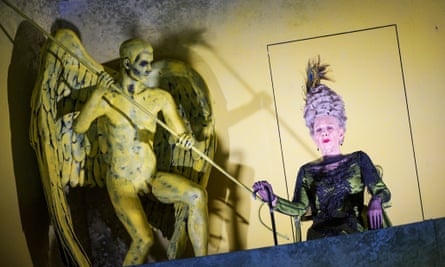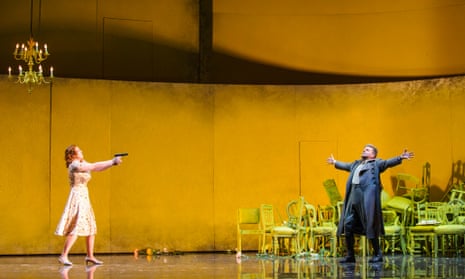Artistically at least, English National Opera and Edward Gardner have come a long way since he took over as music director at the Coliseum in 2007, and his final production in charge there is a good measure of what they have achieved. The orchestra and chorus in this new staging of Tchaikovsky’s The Queen of Spades are outstanding, and the dramatic grip Gardner begins to exert during the prelude never falters over the three-hour span.
The dramatic focus of David Alden’s production is not always, however, quite so consistent. The tragedy is presented very much through the eyes of the central character Hermann, in which reality and obsessive fantasy constantly collide. Even the children’s games in the opening scene seem to be a product of Hermann’s own psyche, while St Petersburg meets Leningrad in Gideon Davey’s designs: historical epochs merge so that Red Army officers are cheek by jowl with the Russian Imperial Guard, and 1960s dresses and between-the-wars three-piece suits are followed by the appearance of Catherine the Great in full rococo splendour.
There are also some of Alden’s characteristic tropes – low-angled expressionist lighting, haphazard jumbles of chairs and a surreal explosion of toy animal heads in the ball scene (a note in the programme helpfully relates that to the phenomenon of “plush” parties, though not, alas, to the world of Tchaikovsky’s opera or to the Pushkin story on which it’s based). Despite the glosses, however, it is only in the last few scenes that the dramatic thread starts to unravel. There may be less clutter on the stage by then, but everything seems to run out of steam, and the ending, which Alden makes bathetic and squalid, almost seems like a footnote.

That’s partly because the outstanding performance of the evening is already over. It does not come from Peter Hoare as Hermann or Giselle Allen as Lisa, the woman who obsesses him, fine and utterly committed though both of those are. It comes from Felicity Palmer, whose portrayal of the older Countess – from whom Hermann is so desperate to learn the secret of the three cards – is an extraordinary tour de force of compelling stage presence, not to mention sustained, quietly beautiful singing in her bedroom scene. Her confrontation with Hermann is the evening’s dramatic high point; after that, everything is a bit of an anticlimax. There is also a wonderfully seedy, coarse Tomsky from Gregory Dahl, and a contained, rather sinister Yeletsky from Nicholas Pallesen, while Alden turns Paulina, Lisa’s confidante (sung by Catherine Young), into a vamp, the good time who’s had by all. The rationale for that, like some other details in the production, though, is hard to explain.

Comments (…)
Sign in or create your Guardian account to join the discussion